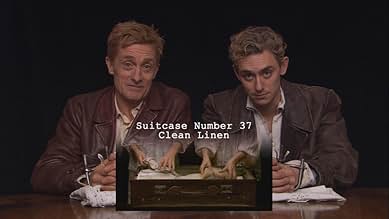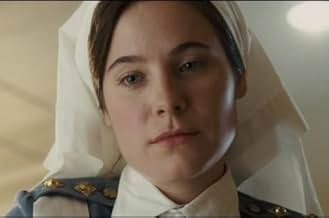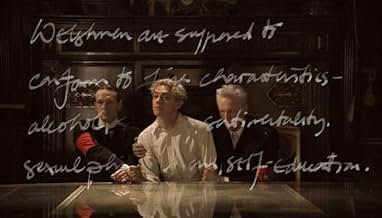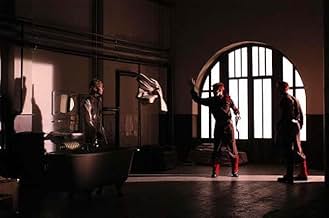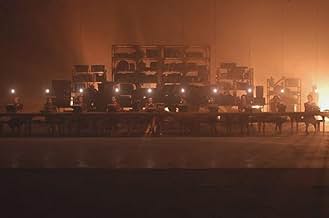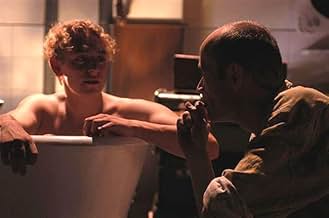Las maletas de Tulse Luper: La historia de Moab
Título original: The Tulse Luper Suitcases, Part 1: The Moab Story
PUNTUACIÓN EN IMDb
6,7/10
1,3 mil
TU PUNTUACIÓN
Tulse Luper de niño durante la Primera Guerra Mundial, como explorador en el Utah mormón y como escritor en Bélgica durante el ascenso del fascismo.Tulse Luper de niño durante la Primera Guerra Mundial, como explorador en el Utah mormón y como escritor en Bélgica durante el ascenso del fascismo.Tulse Luper de niño durante la Primera Guerra Mundial, como explorador en el Utah mormón y como escritor en Bélgica durante el ascenso del fascismo.
- Dirección
- Guión
- Reparto principal
- Premios
- 1 premio y 1 nominación en total
Jordi Mollà
- Jan Palmerion
- (as Jordi Molla)
Nilo Zimmermann
- Pip
- (as Nilo Mur)
Reseñas destacadas
Boy, this is a tricky sonofabitch to evaluate. Tulse Luper is a recurring character in Greenaway's work, kind of a Kilgore Trout to Greenaway's Kurt Vonnegut. And the film makes multiple references to his other works, even citing Luper as their author. And Luper is attributed with having an obsession for categorization and numbering, obsessions inescapably associated with Greenaway's films. But is anything about this truly autobiographical? Is it more akin to Guy Maddin's sense of the poetic autobiography? Or is it just nonsense? Knowing Greenaway, everything in this film is done for very specific (and probably quite complex) reasons. But it's all so elusive and dense with symbolism and double meanings that it's impossible for me to decipher on a single viewing, and I would probably require the use of additional multimedia aids to truly decode it all. Although he hasn't entirely cast aside narrative, it's so shattered by formalist clutter (the literal "frames within frames" as seen in PILLOW BOOK, stylized sets, encyclopedic detail, seemingly pointless use of repetition and contradictory or complementary images) that it's difficult to say "what happens" except in vague terms. As is often the case with Greenaway, it holds almost no emotional resonance (and some of it, especially regarding the Percy character, is kinda stupid). There is no doubt that most would write it off as pretentious drivel. But I found it fascinating nonetheless. It's not the most experimental thing I've ever seen, nor the most unpredictable or surprising. But it's original enough to hold my interest, and it does so with a unique and often beautiful sense of style.
i had read a review of this and the 92 DVDs that are part of the project-and essenetially the project itself rather than the actual film- really interested me. unfortunately only the film is available to see and even though it had a certain spirit it was mostly a struggle to watch. there are some films, where one has to give up on trying to follow a strict narrative or a plot, but rather follow the mood and the visuals and the emotion that the film evokes. "Tulse Luper" seems to be that at the get-go. i was curious and i watched patiently, but the more i watched the more it seemed the technique itself cannot be the most interesting thing going on, especially when the film is only a part 1 and I will have to wait indefinately to see a conclusion. be creative, but be lively and inventive across the border, not just in edit. i think the Pillow Book offered more to the senses and its visual style better served the story.
having said all that i still really badly want to see the project as a whole
having said all that i still really badly want to see the project as a whole
10vdg
How can I write something about this movie
as it's almost impossible to write a review about such a film! Get all the other Greenaway's movies, add a doze of Gillian and Lynch and you can get an idea about what this movie is all about it. I think the students that learn about what film editing means, should use this film as the most perfect example. Multiple scenes flying across the screen, multiple dialogs, theater-like atmosphere and a good music score, adds up to create a unique experience! I have to reckon that I had big expectations about this movie, after reading the reviews, seeing the web site related to the whole story, and of course, seeing all the other Greenaway's movies
and I was not disappointed- this film is something that I have waited to see since long time ago: a blend of reality, imagination and a perfect manipulation of movie editing.
Definitely this movie should be seen in the theater, as its just too small for a normal TV-there is so much information on the screen or maybe if you have a projector at home:)
There are probably lots of `mistakes'(like a very hard to follow script, too many characters...etc) in this film, and many people would not understand a thing, but this is just normal, because there is no other movie that can be compare with this one!
IF you love art movies, and you are prepared to give some `food' to your brain, then see this movie, you won't be disappointed.
Probably, Greenaway's idea of creating this multimedia Magnus Opus would be doomed to a commercial failure, but for the real art lovers, I think the movies created for this project would set a landmark.
10 out 10
Definitely this movie should be seen in the theater, as its just too small for a normal TV-there is so much information on the screen or maybe if you have a projector at home:)
There are probably lots of `mistakes'(like a very hard to follow script, too many characters...etc) in this film, and many people would not understand a thing, but this is just normal, because there is no other movie that can be compare with this one!
IF you love art movies, and you are prepared to give some `food' to your brain, then see this movie, you won't be disappointed.
Probably, Greenaway's idea of creating this multimedia Magnus Opus would be doomed to a commercial failure, but for the real art lovers, I think the movies created for this project would set a landmark.
10 out 10
I watched this several months ago at a local film festival, and to be honest it was not an enjoyable experience. To put it simply the film appears to be a giant experiment in multimedia, the type of thing a film studies phd student might envisage as being worthwhile. If you are fully aware of this before you watch the first film then you may possibly appreciate the work done, if you are looking for something enjoyable then I suggest you look elsewhere. The film oosed pretension, as if the mere act of experimentation could make up for a worthwhile film. If you are the type of watcher who enjoys say special affects rather than plot, or action rather than competent script work then this may be for you.
This is the first film that I have watched at a film festival in about ten years that I can honestly say the vast majority of the audience left the theatre in a state of bemused disgust. It was one of the least enjoyable film experiences I have ever had, right up there with Salo, and UFO: The Movie. Maybe if viewed in sequence with the other parts of the production it might have some worth, but i doubt it. At best it may serve as an educational tool to the many film schools out there...
This is the first film that I have watched at a film festival in about ten years that I can honestly say the vast majority of the audience left the theatre in a state of bemused disgust. It was one of the least enjoyable film experiences I have ever had, right up there with Salo, and UFO: The Movie. Maybe if viewed in sequence with the other parts of the production it might have some worth, but i doubt it. At best it may serve as an educational tool to the many film schools out there...
The Moab Story is part 1 of a 3 part, 6 hour film tracing the life of the eponymous Tulse Luper and, for reasons not yet clear, the history of Uranium (atomic number 92 - this is important so pay attention at the back).
Greenaway continues to evolve his directorial style, overlapping images and sounds, embedding windows within windows, mixing media. The results are often confusing, sometimes stunning, never boring.
I wondered if Greenaway was hinting that this was in some sense an autobiographical piece. Tulse Luper is cited as the author of 'The Belly of an Architect' and in a list of his lost works appears 'The Falls', both earlier films by Greenaway.
Of course it might just be the director playing games. A clip from 'A Zed and Two Noughts' is used at one point, and there is a character named 'Cissie Colpits', the name of the three women in 'Drowning by Numbers'. I suspect there might well have been many more references to earlier films in there.
This is closer in style to 'Properos Books' or 'A TV Dante' than some of his earlier works such as 'The Cook, the Thief, his Wife and her Lover'. Narrative flow has been sacrificed in part for creating a cinematic work of art. Nothing wrong with that in my opinion though, when the result is a film like this. Sit back and let the experience wash over you.
Greenaway continues to evolve his directorial style, overlapping images and sounds, embedding windows within windows, mixing media. The results are often confusing, sometimes stunning, never boring.
I wondered if Greenaway was hinting that this was in some sense an autobiographical piece. Tulse Luper is cited as the author of 'The Belly of an Architect' and in a list of his lost works appears 'The Falls', both earlier films by Greenaway.
Of course it might just be the director playing games. A clip from 'A Zed and Two Noughts' is used at one point, and there is a character named 'Cissie Colpits', the name of the three women in 'Drowning by Numbers'. I suspect there might well have been many more references to earlier films in there.
This is closer in style to 'Properos Books' or 'A TV Dante' than some of his earlier works such as 'The Cook, the Thief, his Wife and her Lover'. Narrative flow has been sacrificed in part for creating a cinematic work of art. Nothing wrong with that in my opinion though, when the result is a film like this. Sit back and let the experience wash over you.
¿Sabías que...?
- Curiosidades'Cissie Colpitts' is the name shared by the three main female characters in Conspiración de mujeres (1988), by the same director.
- ConexionesEdited into The Tulse Luper Suitcases: Antwerp (2003)
Selecciones populares
Inicia sesión para calificar y añadir a tu lista para recibir recomendaciones personalizadas
- How long is The Tulse Luper Suitcases, Part 1: The Moab Story?Con tecnología de Alexa
Detalles
- Fecha de lanzamiento
- Países de origen
- Sitio oficial
- Idiomas
- Títulos en diferentes países
- Les maletes de Tulse Luper: La història de Moab
- Localizaciones del rodaje
- Empresas productoras
- Ver más compañías en los créditos en IMDbPro
Taquilla
- Presupuesto
- 10.000.000 US$ (estimación)
- Recaudación en todo el mundo
- 90.071 US$
- Duración2 horas 7 minutos
- Color
- Mezcla de sonido
- Relación de aspecto
- 1.85 : 1
Contribuir a esta página
Sugerir un cambio o añadir el contenido que falta

